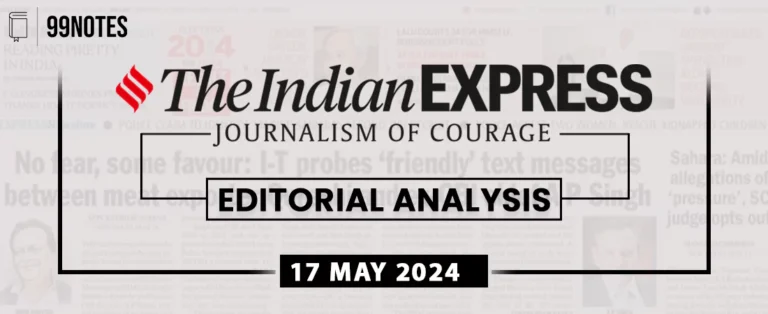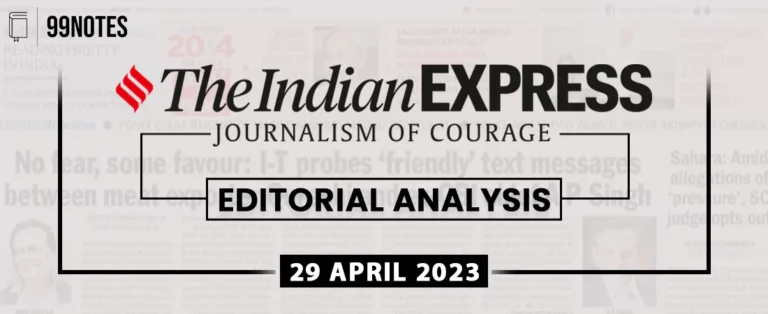10 Feb 2024 : Indian Express Editorial Analysis
Indian Express Editorial Analysis
10-February-2024
1. BITS IN PIECES
| Topic: GS3 – Indian Economy – Effects of liberalization on the economy This topic is relevant for both Prelims and Mains in the context of understanding the role of BITs in attracting foreign direct investment (FDI). |
| Context: |
|
More about the news:
Historical Context and Evolution of BITs:
- India initiated BITs in the mid-1990s, aiming to provide favorable conditions and protection to foreign investors.
- However, the BIT regime gained attention in 2010 with the settlement of the first-ever investor treaty claim filed against India.
- By 2015, India faced 17 known BIT claims, including the high-profile case involving Cairn Energy Plc, which resulted in a substantial award against the Indian government.
Adoption of the 2016 Model BIT and its Implications:
- The adoption of the 2016 Model BIT was driven by concerns over the financial burden resulting from investor-state disputes.
- However, critics viewed it as a protectionist measure lacking nuanced provisions such as “fair and equitable treatment” and “most favored nation.”
- Moreover, the requirement to exhaust local remedies before resorting to international arbitration posed challenges for investors.
Impact on FDI Inflows and Renegotiation Challenges:
- India’s shift towards the 2016 Model BIT coincided with a decline in FDI equity inflows, reflecting investor apprehensions.
- Renegotiating terms with other countries based on the revised text has proven challenging, affecting FDI inflows adversely.
- Government data indicates a significant contraction in total FDI, highlighting the urgency to address treaty-related concerns.
Policy Response and Way Forward:
- India’s departure from the 2016 Model BIT reflects efforts to reinvigorate FDI inflows, particularly amid negotiations for a free trade agreement (FTA) with the UK.
- Addressing disputes settlement mechanisms and ensuring timely resolution through international arbitration is crucial for advancing FTA negotiations and promoting investor confidence.
Parliamentary Recommendations and Future Prospects:
- The Parliamentary Standing Committee on External Affairs has advocated for revisiting the existing BIT regime, emphasizing timely dispute resolution and the development of local expertise in investment arbitration.
- Implementing these recommendations could enhance India’s attractiveness for foreign investments and align treaty practices with global standards.
Conclusion:
- A progressive approach to BITs is essential for India’s economic aspirations, particularly in achieving a $5-trillion economy.
- While the government’s renewed focus on negotiating BITs is promising, a flexible and adaptive approach is warranted to foster sustainable growth in cross-border investment flows and bolster India’s position in the global economy.
| Practice Question: Discuss the significance of Bilateral Investment Treaties (BITs) in the context of India’s economic development and international relations. (250 words/15 m) |
2. If the sun doesn’t shine
| Topic: GS3 – Environment – Environmental pollution and degradation
This topic is relevant for both Prelims and Mains in the context of understanding the country’s efforts to address climate change and reduce greenhouse gas emissions. |
| Context: |
|
More about the news:
Factors Driving RE Growth
- The remarkable growth in RE capacities can be attributed to various factors.
- Policies such as must-run status for RE projects, favorable regulations including late payment surcharge waivers, and renewable purchase obligations have facilitated this expansion.
- Additionally, the reduction in capital costs and increased competition among independent power producers (IPPs), including the entry of foreign investors, have contributed to this growth trajectory.
Challenges and Solutions
- Despite progress, achieving the 500 GW target presents challenges, particularly regarding storage capacities and power exchanges.
- Power demand has surged post-pandemic, leading to growing peak deficits, especially during evenings.
- To address this, generators are increasingly relying on solar and wind projects with long-term power purchase agreements (PPAs).
- Recent bids require hourly demand matching and penalties for shortfalls, necessitating robust storage solutions like battery and pumped hydro storage.
Role of Storage Solutions
- Storage solutions are essential for maintaining grid stability and meeting demand variations.
- Generators may combine solar and wind projects with storage facilities to manage intermittencies and store excess generation during peak hours.
- Pumped hydro storage, with lower capital costs compared to battery storage, presents a viable option.
- However, battery storage’s potential is also recognized, particularly with falling capital costs and government incentives like the production-linked incentive (PLI) scheme and viability gap funding (VGF).
Market Dynamics and Merchant Sales:
- To manage excess generation, options include selling to commercial and industrial consumers or power exchanges.
- Robust power exchange markets are crucial, as more complex dispatchable RE becomes prevalent.
- Merchant sales can impact project bankability, highlighting the need for structures ensuring guaranteed floor prices.
- A central nodal agency could provide this floor price, improving bankability and enabling more competitive prices for discoms.
Implications for Green Hydrogen:
- Building capabilities for round-the-clock (RTC) green energy could support India’s ambitious green hydrogen targets.
- Cost-effective power generation is essential for making green hydrogen projects viable.
- Developing compelling storage solutions and deepening exchange markets are critical for achieving RE capacity targets and green hydrogen ambitions.
Conclusion:
- India’s journey towards achieving net-zero emissions by 2070 relies heavily on the successful deployment of RE technologies and the development of robust storage solutions and market mechanisms.
- Addressing these challenges effectively will not only facilitate the transition to a greener energy landscape but also unlock the potential for achieving broader sustainability goals.
| What is Net Zero Target? |
|
|
PYQ: The term ‘Intended Nationally Determined Contributions’ is sometimes seen in the news in the context of (2016)
Ans: (b) |
| Practice Question: Discuss India’s ambition to achieve net-zero greenhouse gas emissions by 2070 and its reliance on renewable energy as a key driver towards this goal. (250 words/15 m) |
For Enquiry

13 February 2024 : The Hindu Editorial Notes PD

13 Feb 2024 : Indian Express Editorial Analysis

13 February 2024 : PIB Summary for UPSC

12 Feb 2024 : Daily Current Affairs Quiz

12 Feb 2024 : Daily Answer Writing

12 Feb 2024 : Daily Current Affairs

12 Feb 2024 : Indian Express Editorial Analysis

12 February 2024 : The Hindu Editorial Notes PDF

12 February 2024 : PIB Summary for UPSC

10 Feb 2024 : Daily Current Affairs Quiz
Feb 2024 The Hindu 13 February 2024 : The Hindu Editorial Notes PD The Hindu Editorial
13-February-2024
1. A global alliance to bridge the gender equity gap
Topic:…
Indian Express 13 Feb 2024 : Indian Express Editorial Analysis Indian Express Editorial Analysis
13-February-2024
1. A science for us
Topic: GS2 – Governance…
feb 2024 PIB 13 February 2024 : PIB Summary for UPSC PIB Summary for UPSC
13-February -2024
1. Union Minister G Kishan Reddy inaugurate regional centre…
Daily Quiz 12 Feb 2024 : Daily Current Affairs Quiz 12 Feb 2024 : Daily Quiz…
mains answer writing 12 Feb 2024 : Daily Answer Writing Mains Answer Writing
12-February-2024
Q1) “Water scarcity threatens economic and social gains…
Daily Current Affairs 12 Feb 2024 : Daily Current Affairs Daily Current Affairs
12-February-2024- Top News of the Day
1. Great Indian Bustards give Nandyal a…
Indian Express 12 Feb 2024 : Indian Express Editorial Analysis Indian Express Editorial Analysis
12-February-2024
1. CLASSROOM VS COACHING
Topic: GS2 – Social…
Feb 2024 The Hindu 12 February 2024 : The Hindu Editorial Notes PDF The Hindu Editorial
12-February-2024
1. A privileged strategic partnership, without a gulf
Topic:…
feb 2024 PIB 12 February 2024 : PIB Summary for UPSC PIB Summary for UPSC
12-February -2024
1. Birth anniversary of Swami Dayanand Saraswati
Topic:…
Daily Quiz 10 Feb 2024 : Daily Current Affairs Quiz 10 Feb 2024 : Daily Quiz…





